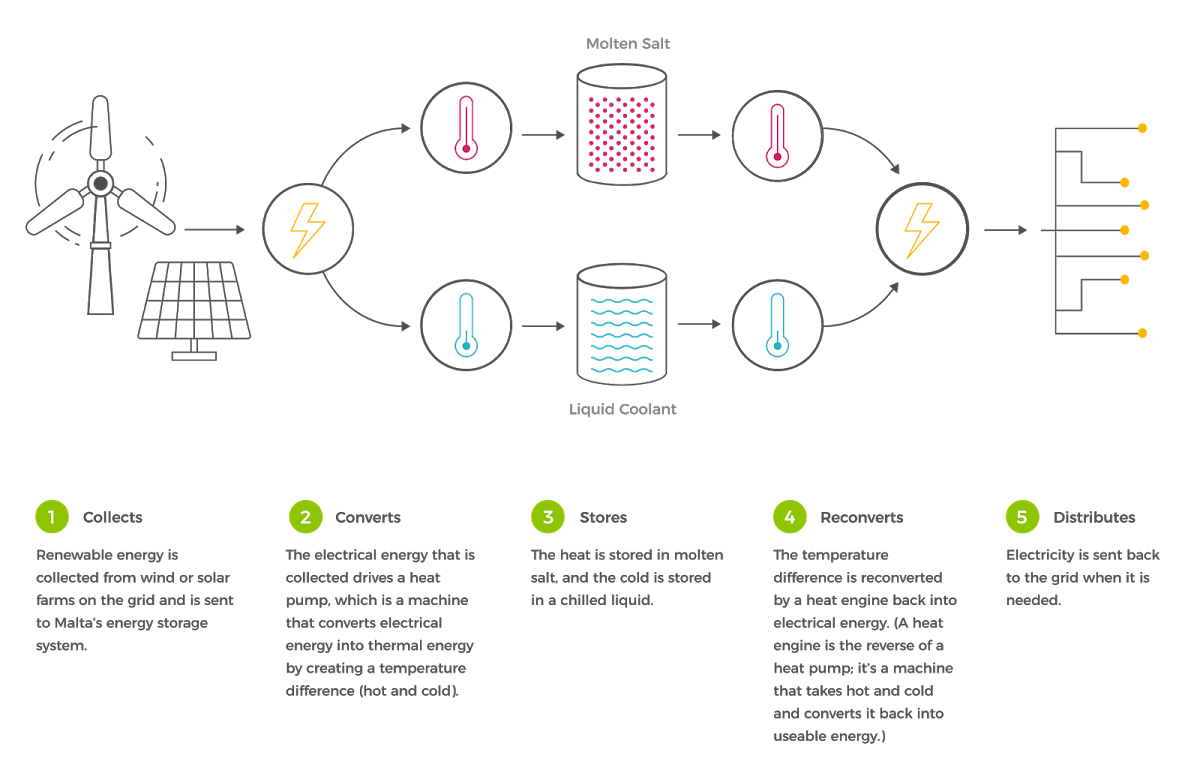
X turns to molten salt and antifreeze for energy storage
Molten salt and antifreeze fluid in vats could become the next generation of wind and solar energy storage, as the Google ‘Malta’ project is brought to life.
The technology is being developed by Google’s parent company Alphabet and, if successful, could join the ranks of other energy storage market leaders such as Tesla.
Alphabet X’s US research lab is searching for a more affordable solution than lithium-ion batteries and also wants to create technology that will allow energy to be stored for up to 40 years.
Sounds crazy, right? Not so much when you use applied science.
Energy storage essential for alternative energy switch
Future tech experts agree that energy storage is essential if the world wants to expand its use of renewable energy sources to help fight climate change and make the transition from dirty fossil fuels.
One of the drawbacks of renewable energy sources is that they depend on weather patterns. If it is not windy or sunny, then less energy is generated. On the other hand, energy can be wasted if the demand for it is not high.

Energy storage is a solution to these problems because it allows us to stock up for a rainy day, pardon the pun, or store excess energy in a bank of reserves when demand is low.
Efficient energy storage would also allow us to mothball gas-fired power plants which are normally used to increase supply when situations are critical. Gas plants are normally used because they are quick to fire up.
We all have climate goals and to reach those, it requires some percentage of electricity to come from storage. The market today is dominated by Tesla’s big ion batteries, which it has been developing for years.
But there are other potential solutions such as pumped hydro, compressed air and flywheels. Hydro is considered to be energy storage because the water store itself is potential energy, which is then released as actual energy when it flows through a turbine and generates electricity.
Compressed air behaves in a similar way, while flywheels capture rotational energy in a spinning mechanical device, which slows down and releases energy when power is needed.
You can find plenty of information about energy storage technology here.
How does the Malta project work?

Malta stores wind and solar power by converting electricity to thermal energy. Heat is stored in molten salt, and cold is stored in a vat of liquid antifreeze solution. When the power is needed, the hot and cold energy is converted back into electricity by a heat engine.
Electricity in the system is produced most efficiently when there is a wider temperature difference between the hot and cold vats. Exotic materials are often needed to maintain high temperatures, but Malta appears to be using common materials.
Similar hot-cold storage technology has been developed using hot water instead of molten salt, but the salt appears to be more energy efficient.
According to X, salt-based thermal energy storage has the potential to be many times cheaper than battery storage because most of the materials necessary — steel tanks, salt and antifreeze — are inexpensive and abundant. The company says its Malta technology may be recharged thousands of times and last for up to 40 years, several times longer than today’s batteries.
What’s next for X’s energy storage project?
X is moving quickly to test commercial viability and is looking for cutting-edge, innovative industry partners to help bring this system to life.
The next step is to build a megawatt-scale prototype plant which would be large enough to prove the technology at commercial scale. We are looking for partners with the expertise to build, operate and connect a prototype to the grid. Also, we are interested in talking to customers of grid-scale energy storage, energy system manufacturers, and energy system construction companies.
Learn about saving on energy from our Energy Experts
The Malta Project is still in the research process, so its benefits may not be seen for a while. But Leading Edge Energy can keep you updated on the latest, most relevant developments in energy technology as well as the electricity and gas market. You can read all about this in our Insights section.
And if you’re interested in benefiting from renewable energy now, our Energy Experts can help you procure a rooftop solar and battery storage system for your business. Learn more about the advantages of installing a rooftop solar system or give us a call at 1300 852 770 or e-mail us at hello@leadingedgeenergy.com.au for experienced professional energy efficiency consultation













